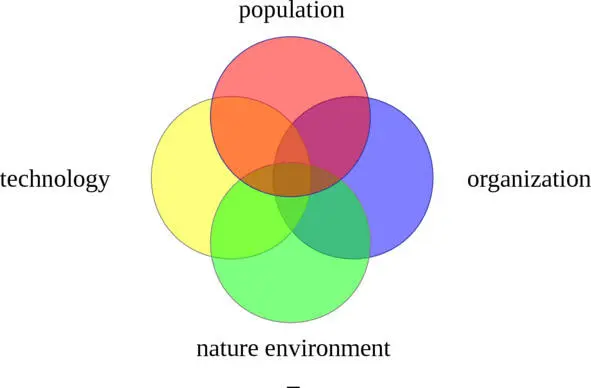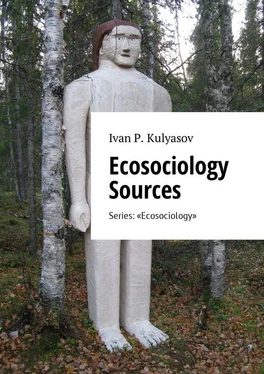I. Kulyasov - Ecosociology Sources. Series - «Ecosociology»
Здесь есть возможность читать онлайн «I. Kulyasov - Ecosociology Sources. Series - «Ecosociology»» — ознакомительный отрывок электронной книги совершенно бесплатно, а после прочтения отрывка купить полную версию. В некоторых случаях можно слушать аудио, скачать через торрент в формате fb2 и присутствует краткое содержание. ISBN: , Жанр: Прочая научная литература, на английском языке. Описание произведения, (предисловие) а так же отзывы посетителей доступны на портале библиотеки ЛибКат.
- Название:Ecosociology Sources. Series: «Ecosociology»
- Автор:
- Жанр:
- Год:неизвестен
- ISBN:9785449009913
- Рейтинг книги:5 / 5. Голосов: 1
-
Избранное:Добавить в избранное
- Отзывы:
-
Ваша оценка:
- 100
- 1
- 2
- 3
- 4
- 5
Ecosociology Sources. Series: «Ecosociology»: краткое содержание, описание и аннотация
Предлагаем к чтению аннотацию, описание, краткое содержание или предисловие (зависит от того, что написал сам автор книги «Ecosociology Sources. Series: «Ecosociology»»). Если вы не нашли необходимую информацию о книге — напишите в комментариях, мы постараемся отыскать её.
Ecosociology Sources. Series: «Ecosociology» — читать онлайн ознакомительный отрывок
Ниже представлен текст книги, разбитый по страницам. Система сохранения места последней прочитанной страницы, позволяет с удобством читать онлайн бесплатно книгу «Ecosociology Sources. Series: «Ecosociology»», без необходимости каждый раз заново искать на чём Вы остановились. Поставьте закладку, и сможете в любой момент перейти на страницу, на которой закончили чтение.
Интервал:
Закладка:

Schema: Social ecological complex
Park proposed an analogous structure of the socio-ecological process and studies of movement in time and space (communication and migration) as well as unique events (artefacts) determined by culture. Duncan and Schnore focused on the functioning of social organization, believing that this component was of most importance for their research. Making a social organization the subject of their analysis within the framework of ecosociology, they used quantitative methods and, based on the data obtained, proposed a thesis that it is a collective adaptation of the human population to the environment.
This approach was also different from that proposed by Park, where the population of a city, state, country and planet represented the macro level. A new understanding of the socio-ecological process as the functioning of a social organization allowed ecosociologists to conclude that samples of interactions that provide an ecological niche for the community, are the analytical unit. Therefore, society was viewed as a human population that was trying to use the environment’s resources to preserve itself (survive) through adaptation.
However, understanding the importance of the space-temporal linking of the social organization’s interactions being described and analyzed, ecosociologists were yet unwilling to use physical characteristics of the natural environment for their analysis. This was due to an observation that the physical environment in cities is much technologized and designed to suit the needs of humans rather than the biota.
Accordingly, in cities, the main impact on human population is made by the social environment, which replaces the natural environment. Ecosociologists then described and interpreted social phenomena using biological terms as “predatory”, “parasitic”, “dominating” and “symbiotic” relationships. This method was to socialize and defend the independence of their discipline.
The approach taken by Duncan and Schnore was perceived as oppositional to other approaches to studying the social organization, namely, the culturological and behaviorist approaches. However, this was an opposition to the constructivist approach that used new but already proven tools and methods of research that were getting closer to an explanation of social reality.
Sociologists-culturologists tended to make descriptions or analyses, starting and ending with social sphere, without any space-temporal linkage. Sometimes, they did use the word “nature”, not in the sense of nature proper but intending to emphasize an unconditional, inborn, natural quality of a social objects or subject.
For ecosociology, explanations offered by behaviorists were considered unacceptable at the macro level because no individual and collective human behavior existed at this level. At the macro level, interaction was limited to social institutes and structures (consisting of organizations) in the context of climatic zones, continents and other major space-temporal natural formations.
There was no way of determining social organization via neither existing cultural conditions nor social-psychological behavior-related affirmations. The new methodology proposed by ecosociologists enabled a breakthrough in studying the phenomena of human behavior and culture. The principle of functional interaction of the environment and social organization, as well as the well-developed conceptual framework of biology made ecosociology popular but could not be used for getting closer to explaining many causes of human interactions.
However, sociology and other humanitarian disciplines recognized that the physical environment can and does influence society and human behavior. Therefore, sociology branched out into the old “traditional” sociology, which maintained that social facts could be explained only with other social facts, and a new environmental (ecological) sociology.
Traditional sociology, using a sociologism-based approach, developed an attitude to inter-disciplinarity, which looked more as a ban on mentioning physical and biological environment. There also existed a disciplinary ban on status accounting for ecosystems and the consequences of their impact on humans and human communities. Violators, labeled as naturalists, were shunned by sociologists, who refused to quote or even notice them. Despite this, in the first half of the 20 thcentury, several sociological works, linking human activity to the environment, were published.
Radha Kamal Mukherjee (1889—1968) was one of the first to conduct inter-disciplinary studies in the field of regional ecology within the framework of the sociology of labor. This research was done in India, a country different from the United States in many specific aspects 22 22 Mukerjee R.K. The regional balance of man // American Journal Sociology. 1930. №36. p. 455—460.; The ecological outlook in sociology // American Journal Sociology.1932. №38. p. 349—355.
.
Pitirim Aleksandrovich Sorokin (1889—1968) in his book “ Man and society in calamity ” summarizes almost 25 years of observations of social catastrophes, ranking epidemics and hunger together with revolutions and wars 23 23 Sorokin P.A. Man and society in calamity. New York: Dutton. 1942.
. He links social degradation and crises to natural calamities and catastrophes, which always go hand in hand.
Paul Henry Landis (1901—1985), within the framework of rural sociology studied miner’s communities and their social structure, linking cultural change in these communities to accessibility and richness of natural resources and other factors of the natural environment 24 24 Landis P.H. Man in environment: An introduction to sociology. New York: T.Y. Crowell Company. 1949.
.
Fred Cottrell , in his studies of industrial sociology, analyzed interrelations between cultural forms of society and forms of energy. He concluded that the human civilization directly depends on technology and kinds of energy being used, showing the path of evolution from antiquity to the nuclear age, progress made by society and the resulting influence of economic, moral and social aspects. The issues relating to generation, transformation, distribution and consumption of energy remain one of the most serious issues over the entire history of civilization 25 25 Cottrell F. Energy and society: The relation between energy, social change, and economic development. New York: McGraw-Hill. 1955.
.
In the late 1960s – early 1970s, this gave rise to the following three organizational changes, which made possible further strengthening of ecosociology as a sub-discipline of sociology:
1) An informal group of sociologists, studying interactions as related to natural resources and natural resource use, splintered from the Society for Studies of Rural Problems;
2) The Society for Studies of Social Issues established a division for research of environmental issues;
3) The American Sociological Association established a committee for ecosociology. The main subjects of ecosociological research were natural resource management, recreation in wild nature, ecological movement and public opinion on ecological problems.
Ecosociology saw its practical tasks as being elaboration of models and programs for restoring the quality of the natural environment. This pragmatism ensured strong financial support for the research from interested business and the authorities. This allowed expanding the scope of socio-ecological approach, provided new explanations of causes behind typical interactions of society with the natural environment, including erroneous interactions fraught with adverse consequences for humanity and nature.
Читать дальшеИнтервал:
Закладка:
Похожие книги на «Ecosociology Sources. Series: «Ecosociology»»
Представляем Вашему вниманию похожие книги на «Ecosociology Sources. Series: «Ecosociology»» списком для выбора. Мы отобрали схожую по названию и смыслу литературу в надежде предоставить читателям больше вариантов отыскать новые, интересные, ещё непрочитанные произведения.
Обсуждение, отзывы о книге «Ecosociology Sources. Series: «Ecosociology»» и просто собственные мнения читателей. Оставьте ваши комментарии, напишите, что Вы думаете о произведении, его смысле или главных героях. Укажите что конкретно понравилось, а что нет, и почему Вы так считаете.




![Джеймс Купер - Пионеры, или У истоков Саскуиханны [The Pioneers, or The sources of the Susquehannah]](/books/395797/dzhejms-kuper-pionery-ili-u-istokov-saskuihanny-t-thumb.webp)







